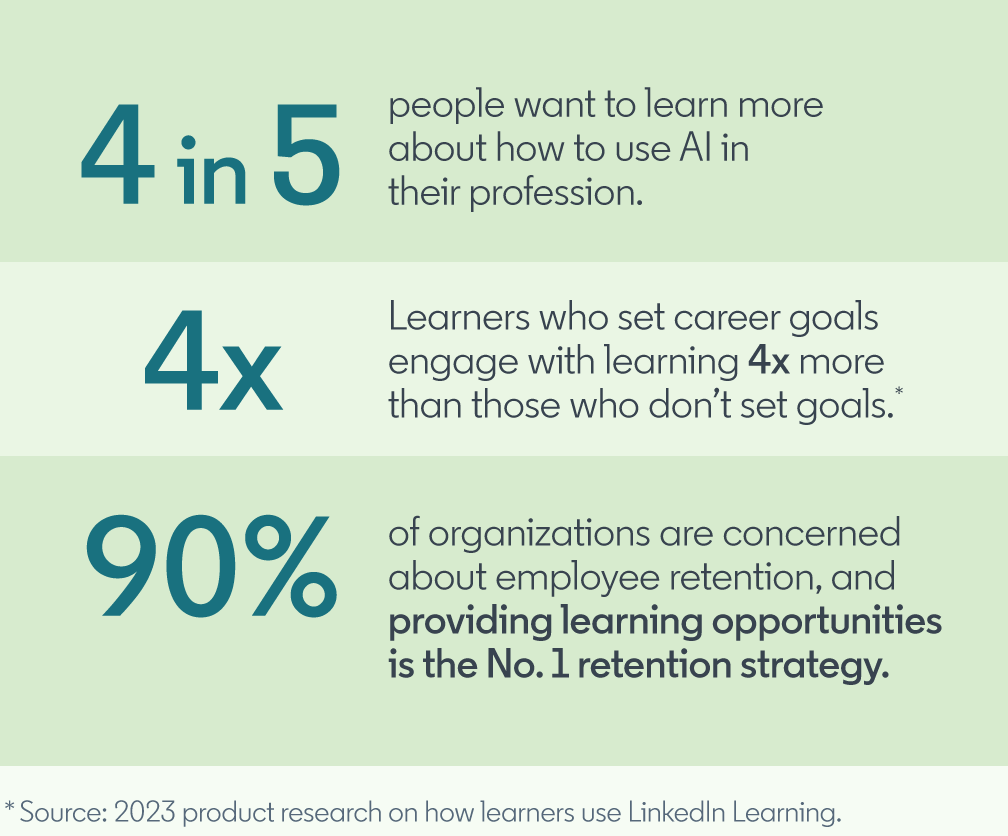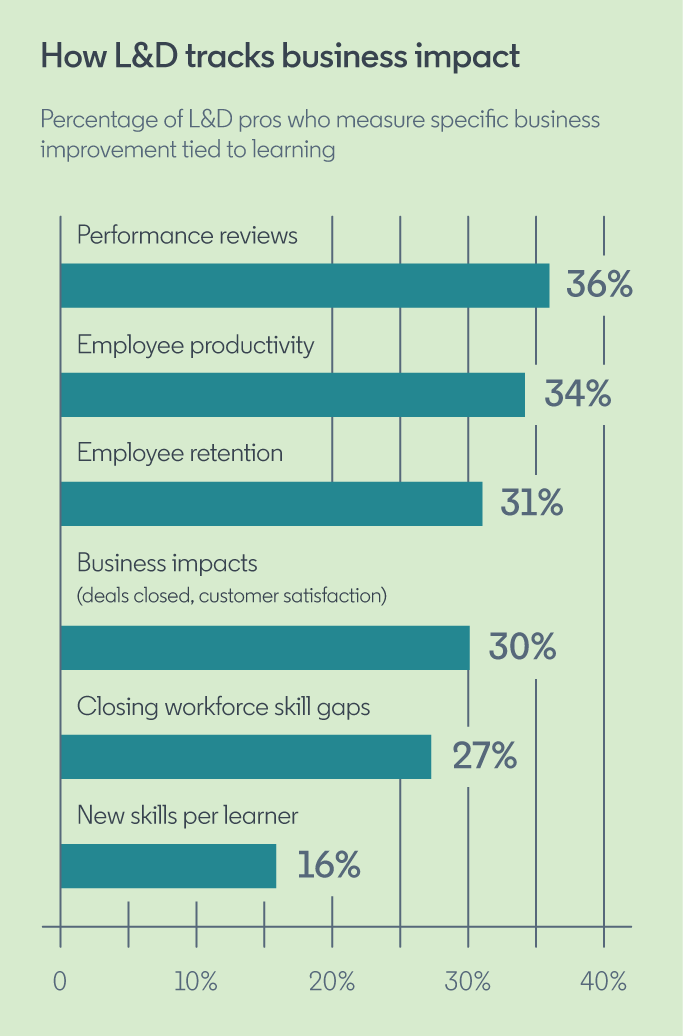
L&D powers the AI future
The AI era is here, and leaders across learning and talent development have a new mandate: help people and organizations rise to opportunity with speed and impact.
As AI reshapes how people learn, work, and chart their careers, L&D sits at the center of organizational agility, delivering business innovation and critical skills. This report combines survey results, LinkedIn behavioral data, and wisdom from L&D pros around the globe to help you rewrite your playbook for the future of work.
Read on for data, advice, and bold ideas.

Show all top 10 focus areas
Show all top 10 focus areas
Additional L&D focus areas for 2024
6. Supporting employees through organizational change
7. Improving learner engagement
8. Measuring the success of learning programs
9. Ensuring diversity, equity, and inclusion
10. Promoting employee well-being
AI skills and career development fuel success.
The business case for learning is clear.
Learning amplifies connection and purpose.
Another talking point: learning is a secret sauce for camaraderie and meaning. As organizations continue to grapple with how best to engage dispersed and diverse teams, learning enhances people’s sense of connection and significance in their work.
In short, organizations that invest in learning will reap the reward of having people who are more invested in their organization’s success.

To thrive in the AI era, companies must empower everyone to grow.
Tomorrow’s success requires skills agility — harnessing the right skills at the right time for the right work.
To unlock skills agility for their organizations, L&D pros must first let go of time-consuming tasks of the past — like laboring over custom content and lengthy training sessions. AI holds great promise for personalization, allowing more individuals to chart their professional destinies.
Likewise, career development and internal mobility programs that align individual aspirations with organizational business priorities represent the path to accelerated progress.
Let’s look at what’s helping organizations build nimble and adaptable skills at scale.

Gen Z wants to grow, even more than other generations.
By nature, younger workers start in entry-level jobs and are the hungriest for advancement. Companies that want to attract and engage Gen Z, the rising cohort of workers born after 1996, are wise to tap into the generation’s passion for progress. If there’s any doubt about whether Gen Z wants to learn and grow, the numbers add clarity.

Coaching is popular. AI can expand its scale.
Internal mobility is a growing spark — that requires fuel.
Mobility takes a village and merits a dedicated leader.
Because internal mobility is a newer goal for many, the question of where it sits in an organization’s structure can be muddy. Does talent acquisition lead these efforts, or L&D, or another group?
Two things are clear:
Shared leadership is common. For more than a third of organizations, internal mobility is shared between two or more roles and often includes the head of HR.
Ownership frequently sits at the top of human resources. In almost half (48%) of organizations, the head of HR owns or co-owns responsibility for leading mobility.
L&D can seize the day and lead the way.


Impactful tactics — and bold ideas — inspire a brighter future.
While learning leaders face daunting demands, it pays to cultivate a purposeful vision. Agile skills are the most valuable gift you can give to people, to your organization, and to yourself.
Read on for actions to prioritize today and ideas to inspire tomorrow.
Priority 1
Lean in to analytics.
Priority 2
Build the right metrics.
Aligning learning to business is still a new muscle for L&D pros. Many are still preoccupied with “vanity metrics,” such as employee satisfaction or the number of trainings delivered (regardless of efficacy).
Success starts with small experiments to gauge progress on critical priorities. For those who do chart business outcomes, productivity and performance are the most common objectives.
Priority 3
Polish your human skills for the age of AI.
Priority 4
Embrace the power of constant growth.
Explore more Workplace Learning data.
Finance | Healthcare | Professional services | Technology
Australia & New Zealand | Benelux | India | Southeast Asia | United Kingdom
Ready for more?
Download the full report and get access to five more unlocked courses to help you master the fastest growing skills for L&D in 2024.
Read methodology & acknowledgements.
Show all top 10 focus areas
Methodology
Survey data
The LinkedIn Learning 2024 Workplace Learning Report surveyed 1,636 L&D and HR professionals with L&D responsibilities who have some influence on budget decisions, and 1,063 learners. Surveyed geographies include: North America (United States, Canada); South America (Brazil); Asia-Pacific (Australia, New Zealand, India, Japan, Cambodia, Indonesia, Singapore, Malaysia, Myanmar, Philippines, Thailand, Hong Kong); and Europe (United Kingdom, Ireland, Belgium, Netherlands, Luxembourg, Norway, Finland, Sweden, Iceland, Denmark, France, Germany, Austria).
LinkedIn Learning product research
The insight that states, “Learners who set career goals engage with learning 4x more than those who don’t set goals” is based on studying a cohort of learners who initiated their LinkedIn Learning account between February 6 and February 10, 2023. We tracked engagement of these learners for the following 3 months and compared the difference in engagement levels for time spent learning between learners who did vs. did not set a career goal.
LinkedIn platform insights
Behavioral insights for this report were derived from the billions of data points generated by the 900 million members in over 200 countries on LinkedIn today. Specific analyses:
Fastest Growing Skills Data
This analysis looks at the Fastest Growing Skills among L&D professionals (globally) between October 6, 2022, and October 6, 2023. “Fastest Growing Skills” are the skills that have seen the largest year-over-year growth among L&D professionals specifically. One way to interpret these findings is to view fastest growing skills as the skills that are already important today — the skills that many members in a given population are developing and adding to their profiles.
Impact of Learning Culture
To determine whether companies have a stronger or weaker learning culture, we calculated the deciles to which they belong in each of the following categories and created a simple scoring index that assigned more points to companies demonstrating these components of learning culture, and fewer points to companies not demonstrating as many components of learning culture:
Skills development: the median number of skills employees added to their profile while they were employed in a position at the company in the last 12 months.
L&D team size: identified 40+ L&D occupations and the number of employees at each company in these occupations.
Learning-related company posts: given the large volume of company posts, we used the Bernoulli method to extract random samplings of company posts in the last 12 months and quantified the number of posts that mentioned ‘learning,’ ‘upskilling,’ and ‘skills’ in English.
The outcomes are defined as follows:
Internal mobility: All data reflects aggregated LinkedIn member activity as of August 2023. We’ve defined internal mobility as any point at which an employee took a new position at the same company in the last 12 months ending August 2023. To calculate internal mobility rates, we included only companies with at least 100 transitions and calculated the median rate.
Leadership promotions: We considered all internal promotions that occurred in the last 12 months by the company and calculated the percentage of leadership promotions that took place (i.e. member was promoted to a manager role or higher).
Retention: the median amount of time that all current employees have been employed with their company.
Acknowledgements
Jenna Alexander at Randstad
Ekpedeme “Pamay” Bassey at Kraft Heinz
Shruti Bharadwaj at Airtel
Naphtali Bryant at Lucas Museum of Narrative Art
Li Juan Cheng at Chint New Energy
Stephanie Conway at LinkedIn
Al Dea at Edge of Work
Guillaume Delacour at ABB
Sara Dionne at Comcast
Dorna Eriksson Shafiei at Atlas Copco
Stephanie Fitzpatrick at UnitedHealth Group
Justin Foster at Radian
Alexandra Halem at Mars
Dr. Terri Horton at FuturePath, LLC
Dani Johnson at RedThread Research
Crystal Lim-Lange at Forest Wolf
Christopher Lind at ChenMed
Chris Louie at Thomson Reuters
Geraldine Murphy at The Heineken Company
Lori Niles-Hofmann at NilesNolen
Amanda Nolen at NilesNolen
Nick Shackleton-Jones at Shackleton Consulting
Jennifer Shappley at LinkedIn
Manpreet Singh Ahuja at PwC India
Sophie Wade at Flexcel Network
Cat Ward at Jobs for the Future
Survey data
Alexander Foss
Stephanie Scalice
Meng Zhao
LinkedIn platform insights
Manas Mohapatra
Cesar Zulaica
Adriana Zurbano
Editorial & production











































